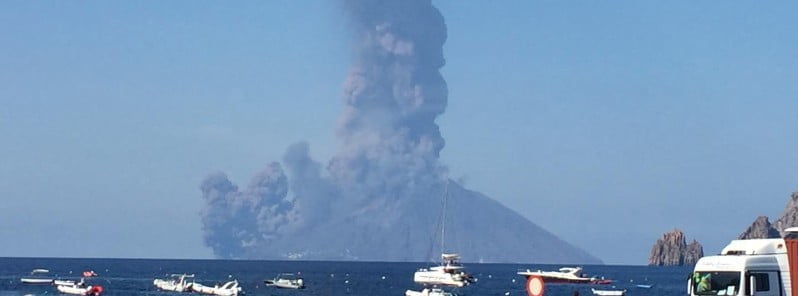New era of violent and unpredictable eruptions at Stromboli volcano, Italy

New research published in Nature Communications suggests the internal ‘plumbing’ system of the Stromboli volcano in Italy may have changed, allowing magma from deep beneath the surface to rise more easily, triggering violent and unpredictable blasts. The research follows a series of surprisingly strong eruptions and paroxysms in 2019.
- While it was previously thought that lava flow was a signal of an upcoming paroxysm, the researchers found that the 2019 Stromboli paroxysms were driven by the arrival of magma from the deep reservoir, heralding a new era of more variable volcanic eruptions at the volcano
Stromboli volcano, which lies on an island off the coast of Sicily, Italy, has fascinated scientists for centuries and is one of the most researched and monitored volcanoes in the world.1
However, a series of eruptions and violent blasts known as paroxysms in 2019 took everyone by surprise. New research suggests that the volcano’s internal ‘plumbing’ system may have changed, allowing magma from deep beneath the surface to rise more easily.
Dr. Chiara Maria Petrone, an expert in volcanoes at the Museum and the lead author of a new study detailing these changes, says, “The rejuvenation of Stromboli’s magma pathways has clear implications for the monitoring of the volcano.
“We need to develop a high-frequency petrological monitoring system to tell us what is happening deeper in the volcano, not just what is happening at the surface.”
“The activity in 2019 was very unexpected,” Chiara says. “All the monitoring signals suggested there Stromboli was more lively than normal, but it remained within the range of expected levels.”
“Even after the major explosion, none of the parameters were really abnormal, and so the two paroxysms weren’t detected until just before they were about to take place.”
Following the first paroxysm, Chiara applied for urgent research funding to investigate what was taking place at Stromboli, and to explain why these events were taking place.
Read more:
➣ Archive of eruptions at Stromboli volcano
While double paroxysms are not unheard of, they are very uncommon. To find out what might be responsible, Chiara and her fellow researchers looked at minerals known as pyroxenes.
They compared the composition and texture of samples taken from Stromboli’s previous eruptions in 2003 to 2017, as well as those from the 2019 eruptions. By examining how these minerals differed, they could gain an insight into the inner workings of the volcano.
While it was previously thought that lava flow was a signal of an upcoming paroxysm, the researchers found that the 2019 Stromboli paroxysms were both driven by the arrival of magma from the deep reservoir.
It began arriving in the system in the months leading up to the paroxysms, picking up in the month before the first and continuing until the second occurred.
Chiara and her co-authors have attributed this to changes in the volcano’s crystal mush, which forms from the partial crystallization of magma.
“We think that there is probably a more direct link between the deeper and shallower reservoirs caused by the magma permeating the crystal mush more fully, allowing magma to rise more frequently. This could explain why the activity of the volcano has become more variable.”
The team has called for the analysis of newly-erupted rocks to be sped up so that researchers can better understand how volcanoes have changed over time.
Abstract
Open-conduit basaltic volcanoes can be characterised by sudden large explosive events (paroxysms) that interrupt normal effusive and mild explosive activity. In June-August 2019, one major explosion and two paroxysms occurred at Stromboli volcano (Italy) within only 64 days. Here, via a multifaceted approach using clinopyroxene, we show arrival of mafic recharges up to a few days before the onset of these events and their effects on the eruption pattern at Stromboli, as a prime example of a persistently active, open-conduit basaltic volcano. Our data indicate a rejuvenated Stromboli plumbing system where the extant crystal mush is efficiently permeated by recharge magmas with minimum remobilisation promoting a direct linkage between the deeper and the shallow reservoirs that sustains the currently observed larger variability of eruptive behaviour. Our approach provides vital insights into magma dynamics and their effects on monitoring signals demonstrating the power of petrological studies in interpreting patterns of surficial activity.2
References:
1 Stromboli’s ‘rejuvenation’ heralds era of more variable volcanic eruptions – Natural History Museum – December 16, 2022
2 Magma recharge and mush rejuvenation drive paroxysmal activity at Stromboli volcano – Chiara Maria Petrone et al. – Nature Communications – December 13, 2022 – DOI: 10.1038/s41467-022-35405-z- OPEN ACCESS
Featured image credit: marco ortenzi (@mortenzi)

Commenting rules and guidelines
We value the thoughts and opinions of our readers and welcome healthy discussions on our website. In order to maintain a respectful and positive community, we ask that all commenters follow these rules:
We reserve the right to remove any comments that violate these rules. By commenting on our website, you agree to abide by these guidelines. Thank you for helping to create a positive and welcoming environment for all.